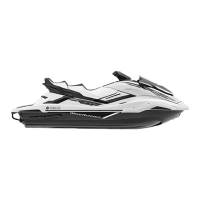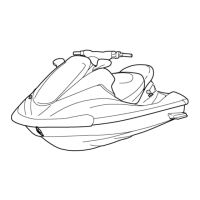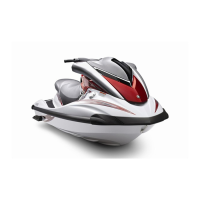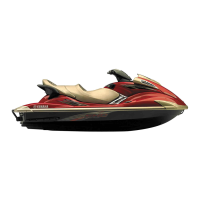Do you have a question about the Yamaha FX HO and is the answer not in the manual?
Details on HIN, VIN, and engine serial numbers for identification.
Location and importance of the Hull Identification Number (HIN).
Location of the engine serial number for identification.
Information on emissions compliance and related labels.
Explains the emission control certificate label.
Information on the manufactured date label.
Explains emission rating labels (stars) and their significance.
Visual guide to important labels on the watercraft.
Explains various warning labels and their meanings.
Describes other miscellaneous labels found on the watercraft.
Operator age, experience, and passenger limits for safe operation.
Guidance on safe operating speeds, conditions, and visibility.
Essential requirements for operating the watercraft safely, including gear.
Warnings about potential hazards and how to avoid them.
Details on watercraft features affecting operation and safety.
Safety precautions and guidelines for water-skiing.
Navigation rules and regulations for operating on waterways.
Sources for additional boating safety knowledge.
Encourages responsible operation for enjoyment and environmental care.
Definitions of key terms used in the manual.
Identifies and locates major parts of the watercraft.
Explains the basic controls for operating the watercraft.
How to use and maintain the remote control transmitter.
Information on the security system and its functions.
Explains the function and use of the engine stop switch.
Operation of the throttle lever for speed control.
How to steer the watercraft using the handlebars.
Operation and adjustment of the Q.S.T.S. for trim control.
Explains different operating modes like Low RPM and No-wake.
How to use the cruise assist feature for maintaining speed.
Overview and function of the instrument panel display.
Understanding the analog gauges for speed and engine RPM.
How to read various information shown on the digital display.
Using the digital speedometer in mph and km/h.
Understanding the hour meter and voltmeter functions.
Monitoring the fuel level and its accuracy.
What the engine overheat warning light and buzzer indicate.
What the oil pressure warning light and buzzer indicate.
What the check engine warning light and buzzer indicate.
General overview of watercraft equipment.
How to remove and install the seats.
Proper use of handgrips for boarding and stability.
Using the reboarding grip for boarding.
How to use the reboarding step to get back on the watercraft.
Function of the bow eye for towing or mooring.
Function of the stern eyes for towing or mooring.
Function of the cleat for tying up the watercraft.
How to use pull-up cleats for mooring.
Using and maintaining storage compartments.
Location and use of the fire extinguisher holder.
Accessing and draining the bow storage compartment.
Accessing and draining the glove compartment.
Accessing and draining the stern storage compartments.
Information on the removable beverage holder.
Details on watertight compartments.
Location of the built-in beverage holder.
Recommended fuel types and safety precautions.
Recommended engine oil type and checking oil level.
Procedures for draining bilge water on land and water.
How the jet vacuum system drains bilge water.
How the electric bilge system drains bilge water.
Safe procedures for transporting the watercraft on a trailer.
Procedures for breaking in the new engine for optimal performance.
Comprehensive checklist before operating the watercraft.
Checks to perform before launching the watercraft.
Checks to perform after launching the watercraft.
Checks related to the engine compartment and its components.
Checks for the fuel system, including leaks and fuel level.
How to check the engine oil level.
Checks for the battery, terminals, and connections.
Checks for the steering system's smooth operation.
Verifying the proper operation of the Q.S.T.S.
Ensuring the throttle lever operates correctly.
Verifying the engine shut-off cord is functional.
Ensuring a fire extinguisher is present and accessible.
Checking the jet intake for debris or blockage.
Ensuring stern drain plugs are secure.
General guidance for operating the watercraft.
Advice for new operators on learning techniques.
Familiarizing yourself with the watercraft's controls and operation.
Correct riding positions for operator and passengers.
Correct passenger riding positions for stability and safety.
Procedures for safely launching the watercraft.
Steps to start the engine once in the water.
How to safely exit the watercraft.
General operation procedures for forward movement.
Techniques for turning the watercraft.
Procedures for safely stopping the watercraft.
Using reverse and neutral gear for maneuvering.
Safe methods for boarding the watercraft.
Specific instructions for boarding the watercraft by oneself.
Procedures for boarding with multiple people.
Starting procedures when the watercraft is on a trailer.
Procedures for starting from a dock.
What to do if the watercraft capsizes.
Precautions when operating in areas with weeds.
Post-operation steps after removing from water.
Steps to take after operating the watercraft.
How to flush cooling water passages.
General cleaning procedures for the watercraft.
Proper care and maintenance of the battery.
How to check battery voltage and electrolyte level.
Ensuring battery bands are not damaged.
Preparation and procedures for long-term storage.
Detailed cleaning instructions for storage.
Lubrication points and procedures.
Applying rustproofing to protect components.
General overview of maintenance practices.
Contents of the recommended tool kit.
Steps for removing and installing the engine cover.
Schedule for routine maintenance tasks.
Procedures for changing engine oil and filter.
Technical specifications for the watercraft.
General guidance on troubleshooting common issues.
A chart listing common problems, causes, and remedies.
Procedures to follow in emergency situations.
How to clean the jet intake and impeller if clogged.
Procedures for jump-starting the battery.
Correct way to connect jumper cables.
Steps for replacing blown fuses.
How to replace the bilge pump fuse.
Safety precautions and procedures for towing the watercraft.
Procedures for handling a submerged watercraft.
Details of the limited warranty coverage.
Information about the optional extended service plan.
Details on HIN, VIN, and engine serial numbers for identification.
Location and importance of the Hull Identification Number (HIN).
Location of the engine serial number for identification.
Information on emissions compliance and related labels.
Explains the emission control certificate label.
Information on the manufactured date label.
Explains emission rating labels (stars) and their significance.
Visual guide to important labels on the watercraft.
Explains various warning labels and their meanings.
Describes other miscellaneous labels found on the watercraft.
Operator age, experience, and passenger limits for safe operation.
Guidance on safe operating speeds, conditions, and visibility.
Essential requirements for operating the watercraft safely, including gear.
Warnings about potential hazards and how to avoid them.
Details on watercraft features affecting operation and safety.
Safety precautions and guidelines for water-skiing.
Navigation rules and regulations for operating on waterways.
Sources for additional boating safety knowledge.
Encourages responsible operation for enjoyment and environmental care.
Definitions of key terms used in the manual.
Identifies and locates major parts of the watercraft.
Explains the basic controls for operating the watercraft.
How to use and maintain the remote control transmitter.
Information on the security system and its functions.
Explains the function and use of the engine stop switch.
Operation of the throttle lever for speed control.
How to steer the watercraft using the handlebars.
Operation and adjustment of the Q.S.T.S. for trim control.
Explains different operating modes like Low RPM and No-wake.
How to use the cruise assist feature for maintaining speed.
Overview and function of the instrument panel display.
Understanding the analog gauges for speed and engine RPM.
How to read various information shown on the digital display.
Using the digital speedometer in mph and km/h.
Understanding the hour meter and voltmeter functions.
Monitoring the fuel level and its accuracy.
What the engine overheat warning light and buzzer indicate.
What the oil pressure warning light and buzzer indicate.
What the check engine warning light and buzzer indicate.
General overview of watercraft equipment.
How to remove and install the seats.
Proper use of handgrips for boarding and stability.
Using the reboarding grip for boarding.
How to use the reboarding step to get back on the watercraft.
Function of the bow eye for towing or mooring.
Function of the stern eyes for towing or mooring.
Function of the cleat for tying up the watercraft.
How to use pull-up cleats for mooring.
Using and maintaining storage compartments.
Location and use of the fire extinguisher holder.
Accessing and draining the bow storage compartment.
Accessing and draining the glove compartment.
Accessing and draining the stern storage compartments.
Information on the removable beverage holder.
Details on watertight compartments.
Location of the built-in beverage holder.
Recommended fuel types and safety precautions.
Recommended engine oil type and checking oil level.
Procedures for draining bilge water on land and water.
How the jet vacuum system drains bilge water.
How the electric bilge system drains bilge water.
Safe procedures for transporting the watercraft on a trailer.
Procedures for breaking in the new engine for optimal performance.
Comprehensive checklist before operating the watercraft.
Checks to perform before launching the watercraft.
Checks to perform after launching the watercraft.
Checks related to the engine compartment and its components.
Checks for the fuel system, including leaks and fuel level.
How to check the engine oil level.
Checks for the battery, terminals, and connections.
Checks for the steering system's smooth operation.
Verifying the proper operation of the Q.S.T.S.
Ensuring the throttle lever operates correctly.
Verifying the engine shut-off cord is functional.
Ensuring a fire extinguisher is present and accessible.
Checking the jet intake for debris or blockage.
Ensuring stern drain plugs are secure.
General guidance for operating the watercraft.
Advice for new operators on learning techniques.
Familiarizing yourself with the watercraft's controls and operation.
Correct riding positions for operator and passengers.
Correct passenger riding positions for stability and safety.
Procedures for safely launching the watercraft.
Steps to start the engine once in the water.
How to safely exit the watercraft.
General operation procedures for forward movement.
Techniques for turning the watercraft.
Procedures for safely stopping the watercraft.
Using reverse and neutral gear for maneuvering.
Safe methods for boarding the watercraft.
Specific instructions for boarding the watercraft by oneself.
Procedures for boarding with multiple people.
Starting procedures when the watercraft is on a trailer.
Procedures for starting from a dock.
What to do if the watercraft capsizes.
Precautions when operating in areas with weeds.
Post-operation steps after removing from water.
Steps to take after operating the watercraft.
How to flush cooling water passages.
General cleaning procedures for the watercraft.
Proper care and maintenance of the battery.
How to check battery voltage and electrolyte level.
Ensuring battery bands are not damaged.
Preparation and procedures for long-term storage.
Detailed cleaning instructions for storage.
Lubrication points and procedures.
Applying rustproofing to protect components.
General overview of maintenance practices.
Contents of the recommended tool kit.
Steps for removing and installing the engine cover.
Schedule for routine maintenance tasks.
Procedures for changing engine oil and filter.
Technical specifications for the watercraft.
General guidance on troubleshooting common issues.
A chart listing common problems, causes, and remedies.
Procedures to follow in emergency situations.
How to clean the jet intake and impeller if clogged.
Procedures for jump-starting the battery.
Correct way to connect jumper cables.
Steps for replacing blown fuses.
How to replace the bilge pump fuse.
Safety precautions and procedures for towing the watercraft.
Procedures for handling a submerged watercraft.
Details of the limited warranty coverage.
Information about the optional extended service plan.
| Starting System | Electric |
|---|---|
| Fuel Capacity | 18.5 gal |
| Displacement | 1812cc |
| Bore x Stroke | 86mm x 78mm |
| Fuel Delivery | Electronic Fuel Injection (EFI) |











